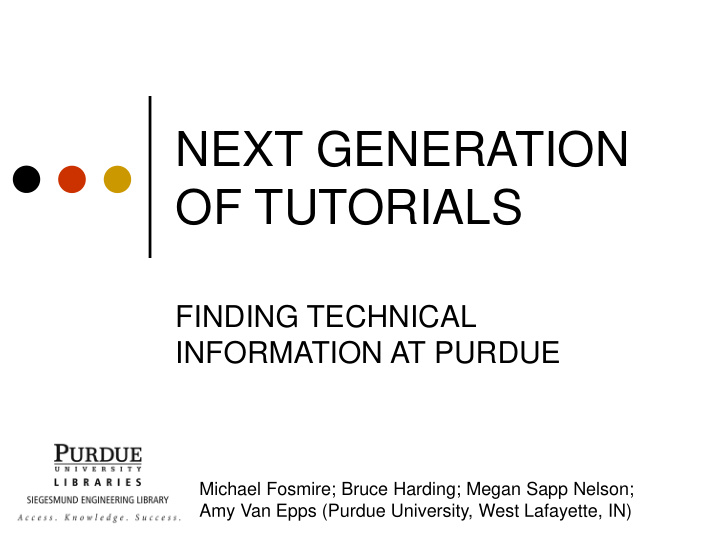



NEXT GENERATION OF TUTORIALS FINDING TECHNICAL INFORMATION AT PURDUE Michael Fosmire; Bruce Harding; Megan Sapp Nelson; Amy Van Epps (Purdue University, West Lafayette, IN)
Background of Treasure Hunt Assignment Originated in 1980’s Has been transformed by new formats and resources, but fundamentally the same goal: To help students articulate needs and locate information that they may come across in their careers Applicable to many disciplines and levels in engineering and technology Can be a group or individual activity
Sources of Questions Texts References & handbooks Catalogs Dictionaries Patents & trademarks Historical Company information Material specifications Standards Current events /campus life Receive questions from alumni, colleagues, and practitioners who come across ‘interesting’ information needs
Sample of Questions If serviced once a week, what is the minimum number of portable toilets required for a 40-person (31 men / 9 women) migrant work camp? Source: ANSI standard 5 total. 4 for men (1 / 10);1 for women (1 / 10).
Another Question Which three elements spark ‘easily’ when held to a grinding wheel? Source: Handbooks Answer: Iron (Fe), Titanium (Ti), Cerium (Ce).
Challenge of Treasure Hunt Students inaccurately guess topic of question. Required to select the appropriate category for previous webliography. Students do not recognize key terms Or students do not have knowledge to accurately guess which topic is appropriate.
Expert Systems Simulate knowledge of an expert Narrow, well-defined domain Respond to user input Use in libraries is not new Not widely known/used Commonly used for database selection
Developing the content of the expert system - Thesauri Started with archive of past questions Staff created thesauri containing variety of terminology used in questions Example: Fasteners list features: ANSI (inch) rivets Belt rivet Black metal washer Bolt Button head rivet Clipped flat washer
Developing the content – Logic Statements Created logical statements that reflect the questions. Example: “What are the angles on the countersink portion of a 00 bell type counterdrill?” Thesauri contain keywords – counterdrill in “tool” thesaurus If (tool) then standard
Programming the Expert System Began with Open Source product CLIPS Problems with the logic Now home-grown, written in C# Logic statements working as expected Web interface, Google-like search box Will accept full-text of the question
Screen shot of Expert System
Animated Tutorial Addresses more learning styles: Visual, textual, kinesthetic Increases engagement by students Varied paths through tutorial Can concentrate on individual needs Provides background/context for expert- system users ‘Browse,’ rather than ‘search’ approach Links to expert system results—integrates two approaches
Tutorial sample shot
Tutorial sample shot
Pre-test and Post-test Pre and post-tests given Prior to tutorial implementation and after Pre-test: self-assessed ability to use sources Post-test: repeat of self assessment and change in confidence in using sources
Pre- and Post-test questions Questions asked Ability to use the online catalog Determining when to use a particular source Ability to use standards, patents, handbooks, codes, encyclopedias and dictionaries
Results Repeated Measures t-test by material type Pre-Tutorial Post-Tutorial Fall 2006 Spring 2007 8.574979 6.902311 Library catalog When to use technical information 7.235174 5.686069 Standards 6.60359 7.382625 4.916889 3.31599 Handbooks 5.748451 5.008601 Patents 5.541192 4.544838 Codes 1.692071 0.992933 Encyclopedias Dictionaries 0.291111 -1.27273 > ± 2 = statistically significant
Results Testing for changes between Fall 2006 and Spring 2007 Between Groups Type of material t-scores -0.925 Library Catalog -0.74075 When to use technical information Standards -1.05912 -0.25441 Handbooks Patents 0.012309 -0.39745 Codes 0.366887 Encyclopedias Dictionaries 0.15987 > ± 2 = statistically significant
Results Reduction in number of reference transactions Indicates students were consulting the tutorial initial direction on sources to use Semester Number of Number of Transactions students transactions per student Spring 90 546 6.1 2006 Fall 2006 63 323 5.1 Spring 80 295 3.7 2007
Conclusions Tutorial had a positive impact No adverse effects on student learning of the material Student scores on the assignment not markedly different than other semesters
Questions? Michael Fosmire (fosmire@purdue.edu) Bruce Harding (harding@purdue.edu) Megan Sapp Nelson ( msn@purdue.edu ) Amy Van Epps ( vanepa@purdue.edu )
Recommend
More recommend